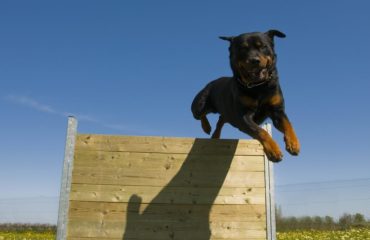Lockdown Tips: Training A Dog To Walk On A Lead

Lockdown is continuing to pose some restrictions on everyday life and, with us cooped up at home for most of the time, your dog may be going a little stir crazy with excess energy. A dog that is not mentally or physically stimulated can start to display boisterous and problematic behaviour, so what better time to go back to basics and train your pooch to walk on a lead, rather than allowing them to tear about your home.
Many people think that dogs know innately know how to walk on a leash, but this skill is one which needs to be learned through consistent training and practice. Dedicating some time each day to practising on the lead means that next time you go for your daily walk, you’ll both be calm enough to value every moment. This skill is especially important if you have a very young or large breed of dog who may end up dragging you down the street without the correct training.
Here are some expert tips from Benchmark Kennels for training your dog to walk safely and calmly on a lead without tugging. Once you have used the right positive training techniques and mastered training a dog to walk to heel, your daily dog walks will be far more enjoyable and stress-free for both you and your furry companion.
Introduce your dog to the collar and lead
Begin by allowing your dog to get used to wearing its collar around the home. If you have had your puppy for a few weeks and are getting ready to take them outdoors for the first time, start putting on their collar for them to wear around the house. The feeling of a collar will be unfamiliar to your dog at first, but after a while, they will hardly notice they are wearing one at all. Your dog can wear its collar for short periods of time inside the house while you are playing, giving them treats and making them feel comfortable. It’s best to start off with lightweight and flexible collars so your dog does not feel restricted or uncomfortable and make sure the collar is not too tight.

Once your dog is not fazed by the collar, you can bring the lead into the picture. Have plenty of treats to hand and practise walking around your home and garden slowly with your dog. Make sure not to pull your dog around with the lead and instead let them walk and move at their own pace, keeping the lead loose so your dog is less aware that they are being restricted.
Training a dog to walk to heel
When your dog is fine wearing a collar and lead and moving around your home with you, you can try to tackle the walking technique. While it takes time for a puppy or untrained dog to heel on a lead, if you can get it right, your life on walks will be so much easier. Make sure you use treats, so your dog has a positive association with walking to heel and practise walking a few steps at a time before standing still and asking your dog to sit. This way, your dog will associate treats with walking by your side and sitting when you stop.
As soon as your dog turns and looks at you reward him with a little treat. After a few tries, you will notice your dog is not only focusing on you but is also coming over to you for the promise of a treat.
Introduce your dog to a distinctive cue sound that signifies food is coming. Some owners like to click and treat, some use an affirmative word like yes and others click with their tongue. Whichever method you choose to use is essentially the same, in a mostly quiet area free of sounds and loud background noise, with your dog on a leash, make the signature sound.
If your dog pulls ahead, do not pull them back or use force to stop them, simply stand still and wait till they stop pulling, then reward them with a treat and go again. Over time, your dog will realise that pulling doesn’t get them where they want to go any quicker and your walks will become far more enjoyable.
Venture outside
You are now ready to test your dog’s skills outside of your usual quiet space at home. There will be many challenges, smells, sounds, and sights to cause distraction, whether you are training a new puppy or an older dog that will test your dog’s newfound walking skills. It is important to be patient with your dog and keep the walks short for a while. If your dog starts to pull ahead on walks out of excitement, be consistent with your at-home training and stop walking, then reward your dog with a treat when they
Always keep your eyes on them, so if your dog looks likely to lunge at something, get suddenly distracted, or start pulling on the lead you can immediately move away or stop walking. If your dog follows suit, always reward them with a treat.
It can be difficult to be 100% consistent when out and about and training a dog to walk on a lead properly, so dedicating certain walks to be complete training sessions can be more effective. On these walks, make sure you are strict and firm with your dog, taking plenty of treats for rewarding your dog when it walks by your heel. On days where you are limited for time, use a different lead, and let your dog off to run around so they can get plenty of exercise without letting any of their lead skills slip away.
Need an outdoor kennel for your dog to spend time?
While dog walking training can be lifechanging for both dog owners and their animals, Benchmark Kennels are manufacturers of bespoke dog kennels, providing dog owners of all breed types, sizes, and temperaments with a secure and spacious place for dogs to kept outdoors. With each kennel being custom-made, you can choose the specific size, material, properties, and structure of your kennel to ensure that it suits your dog and property.
You can order a wooden or WPC eco-thermal dog kennel directly via our website today or enquire over the phone to hear more about our highly respected range of kennels.





You must be logged in to post a comment.